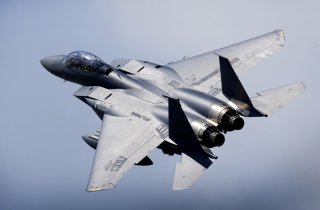JASSM-ER: This Maneuverable Missile Kills From 500 Miles Down Range
The Air Force and Lockheed have been working to upgrade the software behind the JASSM, a weapon that first emerged roughly ten years ago.
The U.S. Air Force’s continued emphasis on upgrading its legacy aircraft is surging forward in tandem with an effort to keep its decades-old fighters and stealth bombers relevant in a highly-sophisticated threat environment.
Advancing this concept and strategic focus, the Air Force and Northrop Grumman have demonstrated an ability for the legacy B-2 Spirit stealth bomber to fire a cutting-edge, upgraded variant of the Joint Air-to-Surface Standoff Missile, or JASSM. A newly released press statement from Northrop Grumman says that the JASSM-ER (Extended Range) fired successfully from a B-2 bomber this past December, marking a significant shift forward in the realm of standoff air attack. The JASSM-ER, which is the latest variant of the weapon in use by the Air Force, also arms the service’s B-1B Lancer bombers and F/A-18 Hornet fighter jets.
The decision to arm old aircraft such as the B-2 stealth bomber, F-15 Eagle fighter jet, or B-52 Stratofortress bomber with long-range aircraft-launched missiles ensures that they are tactically equipped for serious strikes on enemy air defenses and ground forces from safer stand-off ranges. Most state-of-the-art integrated air and missile defense systems can max out at about a 125-mile range, while these aerial platforms can destroy targets from as far as 500 nautical miles down range.
With this tactical equation in mind, the Air Force and Lockheed have been working to upgrade the software behind the JASSM, a weapon that first emerged roughly ten years ago. The initiative seeks to advance continuous upgrades to the weapon as part of a program known as JASSM Operational Realtime Combat Analysis Increment Two (ORCA). This technical overhaul is designed to improve targeting data linkages, graphical user interface with strike data, and various computer systems pertaining to the weapon’s launch and attack flight.
In essence, ORCA is a functional software upgrade that has become increasingly prevalent among weapons improvement programs. Software upgrades to missiles, launchers, delivery systems, and even projectiles (such as ground-fired artillery) can improve guidance, extend range, refine targeting capabilities, or help build in a programmable fuse. Pre-programmable fuses can give attackers newer, adjustable methods of attack such as proximity detonation, delayed explosives, or certain kinds of variable yield effects, for instance, with weapons such as air-dropped bombs.
While few details regarding the software enhancements are available, it would not be at all surprising if the weapon was being further adjusted to destroy moving targets. Descriptions of the weapon already cite an ability to hit “relocatable” targets, which refers to the tactical advantages associated with striking targets on the move. Improving moving target guidance with technologies such as laser pointing or increasing levels of autonomy for weapon guidance is an area of significant focus for weapons developers, as noted in the Sam.gov description of ORCA. Finally, upgrades will permit the weapons to make in-flight adjustments to hit targets on the move in combat. This capability could, for example, permit commanders to destroy a moving armored column from a fighter jet operating hundreds of miles away—delivering a potentially decisive technical advantage.
Kris Osborn is the defense editor for the National Interest. Osborn previously served at the Pentagon as a Highly Qualified Expert with the Office of the Assistant Secretary of the Army—Acquisition, Logistics & Technology. Osborn has also worked as an anchor and on-air military specialist at national TV networks. He has appeared as a guest military expert on Fox News, MSNBC, The Military Channel, and The History Channel. He also has a Master’s Degree in Comparative Literature from Columbia University.
Image: DVIDS.

